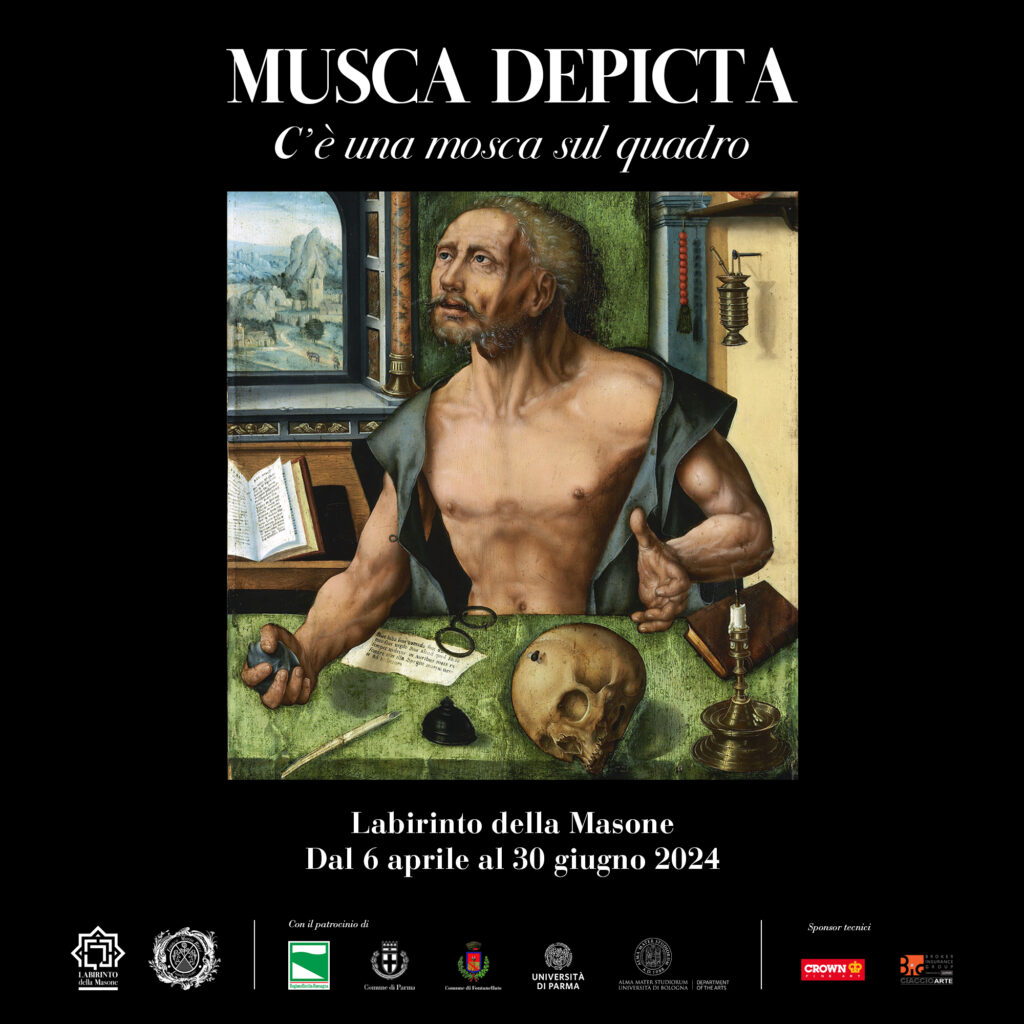
MUSCA DEPICTA
There’s a Fly on the Painting
April 6, 2024 – June 30, 2024
Curated by Sylvia Ferino and Elisa Rizzardi
In spring 2024, the Masone Labyrinth presents MUSCA DEPICTA: There’s a Fly on the Painting, a large and curious new exhibition that traces the appearance of flies in visual art from the school of Giotto to the present day.
A swarm of these small insects will take over the exhibition spaces of the Labyrinth on the occasion of the 40th anniversary of the Franco Maria Ricci publication Musca depicta, featuring an illuminating essay by André Chastel who was the first to examine the artistic incarnation of these pesky dyptera in European painting from the fifteenth to the seventeenth centuries.
The aim of the exhibition is thus to substantially expand upon the arguments set out in the 1984 book, offering a multifaceted view of an insect that has always been considered an intrusive annoyance, and whose representation has, over time, revealed conflicting backstories and curious associations.
More than 50 works including paintings, drawings, sculptures, manuscripts, and printed books will be presented throughout the exhibition and ordered thematically; but as Leon Battista Alberti reminds us in his Eulogy included in an important incunabulum that opens the exhibition, flies are free: hierarchies and territorial limits are unknown to them.
In antiquity, the realistic depiction of a fly in a painting could be interpretated in various ways: as a Christian admonishment to not indulge in worldly things, as an ephemeral little creature representing an artist’s fleeting fame, or even as trickery, a trompe-l’oeil demonstrating the painter’s virtuosity.
The meaning of this illusionistic trick as an end in itself and proof of a certain technical prowess, changed over time. Some considered the fly to be a symbol of death or precarity, common currency in the Vanitas, while others considered it merely an insect among many others, in competition, within still lifes, with the more attractive butterfly.
The (genuine?) sympathy for the fly on the part of Alberti – who went so far as to say: “And thus flies are superior by far and by their great splendour more illustrious than bees” – would soon be transformed into the negative interpretation of Christian symbolism, as seen in the exhibition in the thirteenth-century work of Giovanni del Biondo and that of the Leonardesque Martino Piazza da Lodi.
Strictly adhering to the religious theme is the Memento Mori, linked to bodily decay and the imminence of death: contemporary artist Damien Hirst, who has worked with this insect on several occasions, will take part in the exhibition with his Fear of Death (Full Skull), a skull entirely covered in flies that reprises the iconography that was so present in the art of the sixteenth century. Colourful floral compositions in which a fly has decided to land, by Baroque masters such as Willem van Aelst, Isaak Soreau and Giovanna Garzoni, are included in a room that focuses on the still life, alongside some of the most important printed volumes dedicated to the insect, with watercolours by Ulisse Aldrovandi and elegant drawings by Maria Sibylla Merian.
Flies come to rest indifferently on food and animals in the still and hyperrealistic works by contemporary artist Maurizio Bottoni, while in Yoko Ono’s video FLY it is a naked body that is landed upon and crawled over for 24 minutes.
The bees in the Caravaggesque painting of Orazio Riminaldi call our attention back to Alberti’s earlier provocation.
The exhibition includes loans from prestigious national and international institutions such as the Gallerie degli Uffizi in Florence, the Vatican Museums in Rome, Galleria Sabauda in Turin, the Musée du Louvre in Paris, the Thyssen-Bornemisza Museum in Madrid, and the National Historical Museum in Stockholm as well as numerous private collections together with works from the collection of Franco Maria Ricci.
The exhibition will tantalize not only the eyes but also the ears: the soundtrack of the exhibition is La Folie des Mouches, Variations and Fugue on a Theme by Händel for solo violin, specially commissioned from composer Massimiliano Matesic: the rhythms of a Baroque dance are transposed into hallucinatory and strident virtuosity and moments of lyricism alternate with the simulated buzzing of flies, a sound that is as amusing as it is disturbing.
A new volume was published by Franco Maria Ricci to coincide with the exhibition, with an introductory essay by Sylvia Ferino, a reprint of the critical text by André Chastel, scientific and historical essays by Lucia Tomasi Tongiorgi and Giuseppe Olmi, and a literary text by Carlo Ossola.

